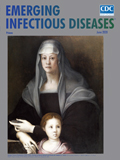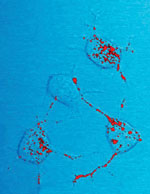
Volume 26, Number 6—June 2020
Etymologia
Etymologia: Scrapie
On This Page
Figures
Downloads
Article Metrics
Scrapie is a fatal neurodegenerative disease of sheep and goats that was the first of a group of spongiform encephalopathies to be reported (1732 in England) and the first whose transmissibility was demonstrated by Cuille and Chelle in 1936 (Figure). The name resulted because most affected sheep develop pruritis and compulsively scratch their hides against fixed objects. Like other transmissible spongiform encephalopathies (TSEs), scrapie is associated with an alteration in conformation of a normal neural cell glycoprotein, the prion protein (PrPC). The scrapie agent was first described as a prion (and the term coined) by Stanley Prusiner in 1982, work for which he received the Nobel Prize in 1997.
The altered, misfolded form, designated PrP scrapie (PrPSc), aggregates and is thought to be an essential component of the infectious particle that causes TSEs. PrPSc is often used to designate the infectious particle responsible for all TSEs, including those in humans, such as Creutzfeldt-Jakob disease, even though scrapie does not appear to affect humans.
References
- Brown P, Bradley R. 1755 and all that: a historical primer of transmissible spongiform encephalopathy. BMJ. 1998;317:1688–92.
- Cuillé J, Chelle PL. The so-called “trembling” disease of sheep: is it inoculable? [in French]. Comptes Rendus de l’Académie Sciences. 1936;203:1552.
- Laplanche J-L, Hunter N, Shinagawa M, Williams E. Scrapie, chronic wasting disease, and transmissible mink encephalopathy. In: Prusiner SB, editor. Prion biology and diseases. Cold Spring Harbor (NY): Cold Spring Harbor Laboratory Press; 1999. p. 393–429.
- Prusiner SB. Novel proteinaceous infectious particles cause scrapie. Science. 1982;216:136–44.
Figure
Cite This ArticleOriginal Publication Date: May 04, 2020























.png)











No hay comentarios:
Publicar un comentario